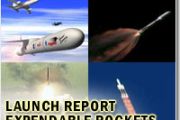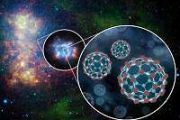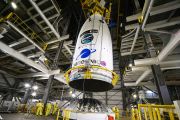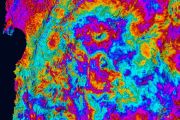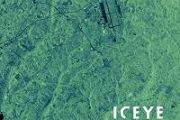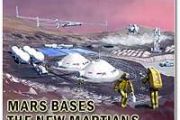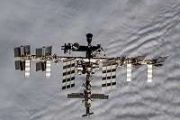
Copernical Team
Maps to improve forest biomass estimates

Fluctuations in the carbon-rich biomass held within the world’s forests can contribute to, or slow, climate change. A series of new maps of above ground biomass, generated using space observations, is set to help our understanding of global carbon cycling and support forest management, emissions reduction and sustainable development policy goals.
Ten years of safer skies with Europe’s other satnav system

With 26 satellites in orbit and more than two billion receivers in use, Europe’s Galileo satellite navigation system has made a massive impact. But our continent has another satnav system that has been providing safety-of-life services for ten years now – chances are that you’ve benefited from it without noticing.
The history of space debris creation
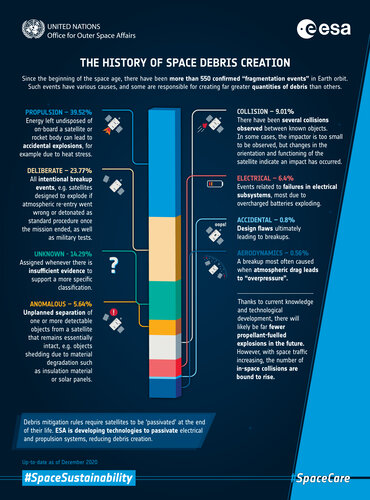 Image:
Learning lessons from the past on space debris
Image:
Learning lessons from the past on space debris Astronauts in crewed missions to Mars could misread vital emotional cues

Living for nearly 2 months in simulated weightlessness has a modest but widespread negative effect on cognitive performance that may not be counteracted by short periods of artificial gravity, finds a new study published in Frontiers in Physiology. While cognitive speed on most tests initially declined but then remained unchanged over time in simulated microgravity, emotion recognition speed continued to worsen. In testing, research participants were more likely to identify facial expressions as angry and less likely as happy or neutral.
"Astronauts on long space missions, very much like our research participants, will spend extended durations in microgravity, confined to a small space with few other astronauts," reports Mathias Basner, professor in the Department of Psychiatry at the University of Pennsylvania Perelman School of Medicine.
Lightning strikes played a vital role in life's origins on Earth
 Lightning strikes were just as important as meteorites in creating the perfect conditions for life to emerge on Earth, geologists say.
Minerals delivered to Earth in meteorites more than 4 billion years ago have long been advocated as key ingredients for the development of life on our planet.
Scientists believed minimal amounts of these minerals were also brought to early Earth throu
Lightning strikes were just as important as meteorites in creating the perfect conditions for life to emerge on Earth, geologists say.
Minerals delivered to Earth in meteorites more than 4 billion years ago have long been advocated as key ingredients for the development of life on our planet.
Scientists believed minimal amounts of these minerals were also brought to early Earth throu Cosmic lens reveals faint radio galaxy
 Radio telescopes are the world's most sensitive radio receivers, capable of finding extremely faint wisps of radio emission coming from objects at the farthest reaches of the universe. Recently, a team of astronomers used the National Science Foundation's Karl G. Jansky Very Large Array (VLA) to take advantage of a helping hand from nature to detect a distant galaxy that likely is the faintest r
Radio telescopes are the world's most sensitive radio receivers, capable of finding extremely faint wisps of radio emission coming from objects at the farthest reaches of the universe. Recently, a team of astronomers used the National Science Foundation's Karl G. Jansky Very Large Array (VLA) to take advantage of a helping hand from nature to detect a distant galaxy that likely is the faintest r New 3D Printed CubeSat measures electromagnetic effects of space storms
 Today Roboze, a manufacturer of industrial 3D printing technology for extreme end-use applications, announced it has been selected by the University of Colorado Boulder to optimize the design and 3D printed components for a CubeSat project within the college's department of Aerospace Engineering Sciences. The CubeSat will spend at least six months in orbit measuring electromagnetic waves emitted
Today Roboze, a manufacturer of industrial 3D printing technology for extreme end-use applications, announced it has been selected by the University of Colorado Boulder to optimize the design and 3D printed components for a CubeSat project within the college's department of Aerospace Engineering Sciences. The CubeSat will spend at least six months in orbit measuring electromagnetic waves emitted LAMOST reveals new footprints of the Gaia-Sausage-Enceladus merger event
 Looking up at the starry sky, the deep Universe appears quiet and mysterious. It is hard to imagine that the ancient dwarf galaxy Enceladus violently collided and was torn apart by our own Milky Way Galaxy, leaving behind the cries of a whole new generation of children from the hundred-handed giant.
Recently, SCIENCE CHINA: Physics, Mechanics and Astronomy published an (Editor's Focus) art
Looking up at the starry sky, the deep Universe appears quiet and mysterious. It is hard to imagine that the ancient dwarf galaxy Enceladus violently collided and was torn apart by our own Milky Way Galaxy, leaving behind the cries of a whole new generation of children from the hundred-handed giant.
Recently, SCIENCE CHINA: Physics, Mechanics and Astronomy published an (Editor's Focus) art Ancient light illuminates matter that fuels galaxy formation
 Using light from the Big Bang, an international team led by Cornell University and the U.S. Department of Energy's Lawrence Berkeley National Laboratory has begun to unveil the material which fuels galaxy formation.
"There is uncertainty on the formation of stars within galaxies that theoretical models are unable to predict," said lead author Stefania Amodeo, a Cornell postdoctoral researc
Using light from the Big Bang, an international team led by Cornell University and the U.S. Department of Energy's Lawrence Berkeley National Laboratory has begun to unveil the material which fuels galaxy formation.
"There is uncertainty on the formation of stars within galaxies that theoretical models are unable to predict," said lead author Stefania Amodeo, a Cornell postdoctoral researc ASU scientists determine origin of strange interstellar object
 In 2017, the first interstellar object from beyond our solar system was discovered via the Pan-STARRS astronomical observatory in Hawaii. It was named 'Oumuamua, meaning "scout" or "messenger" in Hawaiian. The object was like a comet, but with features that were just odd enough to defy classification.
Two Arizona State University astrophysicists, Steven Desch and Alan Jackson of the School
In 2017, the first interstellar object from beyond our solar system was discovered via the Pan-STARRS astronomical observatory in Hawaii. It was named 'Oumuamua, meaning "scout" or "messenger" in Hawaiian. The object was like a comet, but with features that were just odd enough to defy classification.
Two Arizona State University astrophysicists, Steven Desch and Alan Jackson of the School 
